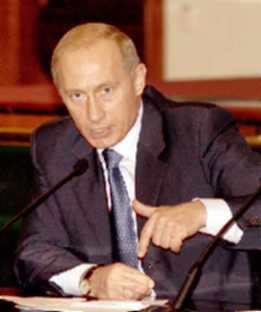|
Missile Tests Underscore Moscow's Desire to Maintain Nuclear Deterrent
by Richard Weitz via rialator - World Politics Review Monday, Jun 4 2007, 11:05am
international /
peace/war /
other press
1 June, 2007
On May 29, the Russian government very ostentatiously tested two different ballistic missiles, designated the RS-24 and R-500. The Russian media characterized both systems as new versions of existing missiles, modified to penetrate U.S. ballistic missile defenses (BMD) more effectively. First Deputy Prime Minister Sergei Ivanov, the former fefense minster, claimed that "these systems can beat any operational and future missile defenses."

American Militarism -- Putin vows response
According to the Russian news agency RIA Novosti, the new RS-24 intercontinental ballistic missile is simply a version of the road-mobile SS-25 Topol ("Sickle") that had been modified to carry up to 10 multiple independently targetable reentry vehicles (MIRVs), each with its own nuclear warhead. The original single-warhead SS-25 entered into operation with the Soviet armed forces in the mid-1980s.
RIA Novosti described the R-500 as a cruise missile adopted for use on a mobile Iskander-M launcher (SS-26), originally designed for tactical ballistic missiles. The R-500 has a range of only 280 km (170 miles), but its maneuverability could make it harder to intercept than a warhead flying a simple ballistic trajectory, such as those employed by the SCUD-based missiles of Iran and North Korea. One of its prime functions would be to help Russia attack the BMD system the Bush administration has proposed deploying in nearby Poland and the Czech Republic.
The immediate purpose of the recent tests probably was to demonstrate Russia's capacity to overcome such potential missile defenses. However, the ultimate reason for developing the RS-24, at least, was Russia's need to reinforce its strategic missile capabilities during what looks to be a period of increased vulnerability over the next few years.
Although it has dismantled many older Soviet systems, Russia still possesses substantial nuclear forces. In the most recent data exchange conducted through the START process, whose treaty-governed counting rules assume that each platform carries the maximum number of warheads tested with that system, the Russia Federation declared that, as of January 1, 2007, it possessed 4,162 "warheads attributed to deployed ICBMs, deployed [submarine-launched ballistic missiles], and deployed heavy bombers." Of these, the Russian Air Force had 14 Blackjack and 64 Bear heavy bombers equipped with nuclear-armed long-range cruise missiles. The Russian Navy's fleet included a dozen nuclear-powered strategic ballistic missile submarines carrying 272 submarine-launched missiles, with at most 1,392 warheads among them. The Russian Strategic Missile Forces (SMF), which have always constituted the strongest leg of Russia's strategic nuclear triad, possessed 530 land-based ICBMs -- 243 SS-25, 136 SS-19, 104 SS-18 ICBMs, and 47 new SS-27 Topol-Ms -- equipped with at most a total of 2,146 nuclear warheads.
While meeting with senior military officers in November 2006, Putin insisted that the Russian defense industry must meet its timetables and provide the country with the new strategic weapons Russia needed to maintain the balance of power. Until now, however, Russian defense firms have built only on average a half dozen new ICBMs annually. This low production level could result in a sharp decline in the number of Russian ICBMs during the next few years since the SMF will soon need to decommission almost all its Soviet-built ICBMs, including the large liquid-fueled strategic missiles that carry most Russian strategic warheads. In January 2007, Lt. Gen Nikolai Solovtsev, SMF commander, told the media that Russia would have to retire over two-thirds of Russia's fleet of 542 land-based ICBMs by 2015. He estimated that the SMF would acquire only 62 new ground-launched strategic missiles by then.
The road-mobile SS-27 Topol-Ms, a more advanced missile than the original SS-25 Topol, represents the foundation of Russia's planned future ICBM arsenal. In early December 2006, the first three mobile Topol-Ms entered into operational deployment with the SMF. Last year, Solomonov said that the mobile SS-27 would serve as Russia's main ICBM through 2045.
Until the START I prohibitions against increasing the number of warheads carried by an existing type of ICBM expire in December 2009, however, the Russian government is prohibited from deploying more than one nuclear warhead on the SS-27. This limitation constrains the effectiveness of the Topol-M as a BMD penetrator as well as its contribution to Russia's overall strategic forces. As Russia decommissions its Soviet-era MIRV-ed ICBMs and transitions to the single-warhead Topol-Ms, the number of nuclear warheads in its ICBM fleet is projected to decline from 1,843 today to 665 by 2012.
In this context, the military's recent missile tests appear to have been a stop-gap measure designed to reassure Russian officials, as well as the Russian electorate during the upcoming parliamentary and presidential elections, that the Russian military can still deter a potential U.S. military attack on Russia. Ivanov, a leading candidate to succeed Putin, said the tests made evident that, "Russians need not worry about defense: they can look confidently to the future."
Putin and other Russian leaders have renounced any intent to match the U.S. military buildup missile-for-missile, expressing confidence that less costly asymmetric responses would prove adequate for maintaining the credibility of Russia's nuclear deterrent. Nonetheless, they still want to underscore to domestic and foreign audiences that Russia retains a formidable nuclear deterrent.
Richard Weitz is a senior fellow at the Hudson Institute.
© 2007, World Politics Review
http://www.worldpoliticsreview.com/article.aspx?id=818# COMMENTS show latest comments first show full comment text
<< back to stories
|